D&M's lakeside launch: the new products from Boston Acoustics, Denon and Marantz
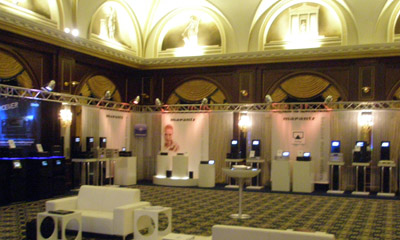
...Well, some of them, anyway: you see, while we've just been briefed about all the upcoming products from the D&M Holdings brands – including new models from Boston Acoustics, Denon and Marantz –, a whole stack of them are under embargo until various times over the next few months.
That's hardly surprising, given that we've been told about some new models you won't even see in the shops until early next year, but it does mean I have to be a bit circumspect about what I can tell you and show you in this blog.

After all, I'm writing this at the event venue on the shore of Lake Maggiore in Italy (left), and the water looks a bit cold should someone at D&M think I've said too much.
Anyway, anyway, the news from D&M – and they've kept it close to the corporate chest, to the extent of not supplying press pictures of products, so what you have here is either lovingly stolen from presentation slides or grabbed at the static exhibition of a mixture of real products and mockups – is networking with everything.
Oh, and enhanced features to simplify set-up and operation, all done without losing sight of the main aims of sound and picture quality.
Both Marantz and Denon are making a big play of the networking features of their receivers, music streaming, internet radio and premium services available on models right down to the £500 Denon AVR-1912.
As well as the usual DLNA/UPnP offerings, along with the likes of Napster and Last.FM, the company says additional services are on the way.
The latest hi-fi, home cinema and tech news, reviews, buying advice and deals, direct to your inbox.
I asked the question about Spotify, which was mentioned the other week on the forums as being a forthcoming Marantz feature, but the official line from both brands is that it's too early to make any official comment on the subject of this or other services.
For which I guess read 'yes, it's on the way, but it's not signed and sealed yet'. Oh, and if even if it's not, you can of course enjoy Spotify on its products via slightly more circuitous routes such as using Airfoil to hijack the sound from your computer and stream it to the components.
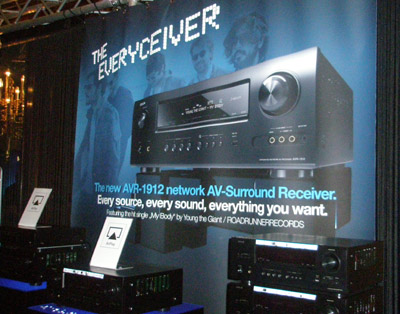
It's enough to have a (perhaps slightly overenthusiastic) Denon Europe marketing team dubbing the new Denon AVR-1912 'The Everyceiver', suggesting that it's all the receiver you'll ever need for music, movies and streaming content.
The slogan was plastered loud and proud on a banner in the showroom the companies had set-up in one of the large conference rooms here, and being promoted in a video ad running alongside.

Really striking is the new user interface (above), available on all but the least expensive new models from both brands.
Not only does this offer an overlaid GUI, it will also walk you through all elements of set-up in 'wizard' fashion: all you have to do is connect your new receiver to a display and the mains, switch on, and the step-by-step process will lead you through all aspects of set-up, connection and tuning.
It's a truly innovative step, and also means most of these new models come without a hefty printed instruction manual: instead you'll get a simple get-started guide, plus a CD carrying a reference manual complete with interactive links to further web resources.
What's more, on some of the lower-end models there will be preset buttons for common functions – watching discs, watching TV, gaming and network listening – and further simple presets for favourite internet radio stations.
The company says it's aware that in some households the radio is a prime source of all-day entertainment, and it wants to make accessing favourite internet radio stations as simple as possible.
AirPlay – and much more
On the subject of networking, while Denon and Marantz have nailed their colours firmly to the Apple AirPlay mast, they're rather more technology-agnostic than that might initially suggest: in place or on the way are a control app for Android, a dedicated iPad control app, and the ability to push content to the company's network devices using the likes of Microsoft's PlayTo technology.
The company gave a workshop demonstration of how all this networked audio (and video) works together, and all worked (relatively) smoothly, considering it was being done in a conference room packed with mobile- and laptop-toting retailers and press.
A few glitches suggested that wireless still has some way to go to be a bombproof plug and play technology, but to be fair it was suggested that, for the most reliable connection, theres's no substitute for cable.

This, by the way, is Denon's arrival in the streaming separates arena, the DNP-720AE: designed to match the company's existing 'Advanced Evolution' stereo range, it's going to come in at a price undercutting existing offerings from rival brands when it launches in the next few months.
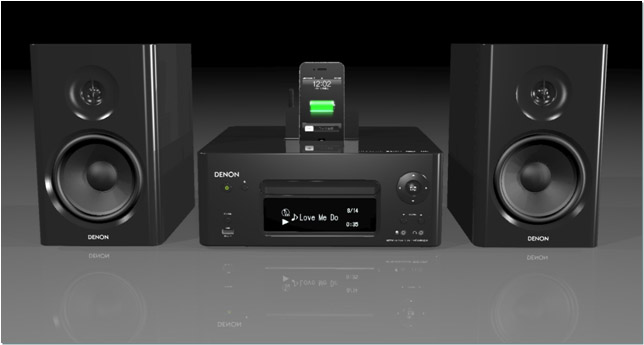
Other interesting features of the static exhibition included the chance to see Denon's CEOL system in its soon-to-be-available black finish: yes, it looks smart, but just a bit conventional? Maybe I'm just used to seeing the network system in white?
Oh, and the realisation that while the Marantz receiver line may look purposeful in black, the lighter finish really shows off the new styling, complete with its porthole display and sculpted front panels.
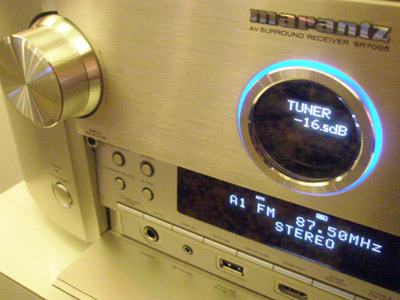
Elsewhere, the story on AV receivers is a familiar one, with more HDMI inputs, including front-mounted ones on some models, and the ability to run two outputs simultaneously on top-end offerings, rather than having to switch between the two.
Yes, it involves extra video processing, but again it adds to the flexibility of the products.
As do facilities such as standby pass-through of HDMI, meaning the family can watch a disc or satellite TV, for example, on the TV without having the whole surround system on, and network standby to speed up access to internet radio and locally stored content as soon as the receiver is turned on, not to mention allowing external network control apps to turn the products on from standby.
To do this, the companies have had to include separate power supplies for the HDMI and network sections of the new products, but they point out that these are much more efficient than rival products which fire up the main power supplies to provide such functionality: the claim is for a consumption of just 3W when using these facilities, against rivals' 25W.
To complete the day, another chance to hear the a-Xperience concept speakers from Boston Acoustics, which I first heard at the Munich High End Show the other week.
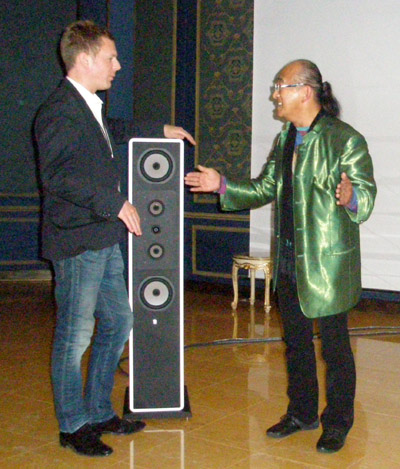
Demonstrated by Brand Ambassador Ken Ishiwata (seen here discussing the design with WHFSV editor Dominic Dawes), the big speakers sounded impressive in a cavernous basement room clearly doing them no favours.
Ishiwata has had a major part in the design of both these speakers and the mainstream Boston A-Series for which they're a standard-bearer, and admitted the speakers had sounded better in the more controlled environment of the Munich demonstration room.
Ken told me that extensive tweaking and tuning had gone on long into the previous night – not surprising when the room had all kinds of open spaces where you really didn't need them, and a marble floor! – and he was using a pretty radical toe-in of around 45 degrees.
But the results were impressive enough to get unprecedented applause from the assembled retailers at the end of Ishiwata's demonstration, and he was able to report that the speakers are no longer just a concept.
They'll be going into production, despite a price-tag in the region of 20,000 euros a pair, and a fighting weight of over 80kg apiece.
Watch this space – we'll do our best to get hold of a pair!
Andrew has written about audio and video products for the past 20+ years, and been a consumer journalist for more than 30 years, starting his career on camera magazines. Andrew has contributed to titles including What Hi-Fi?, Gramophone, Jazzwise and Hi-Fi Critic, Hi-Fi News & Record Review and Hi-Fi Choice. I’ve also written for a number of non-specialist and overseas magazines.
